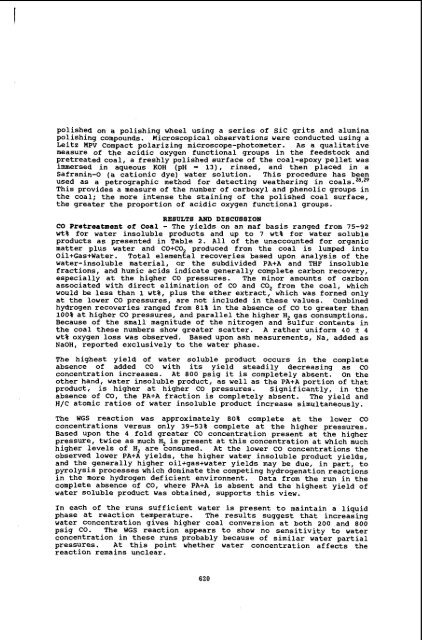liquefaction pathways of bituminous subbituminous coals andtheir
liquefaction pathways of bituminous subbituminous coals andtheir
liquefaction pathways of bituminous subbituminous coals andtheir
Create successful ePaper yourself
Turn your PDF publications into a flip-book with our unique Google optimized e-Paper software.
polished on a polishing wheel using a series <strong>of</strong> Sic grits and alumina<br />
polishing compounds. Microscopical observations were conducted using a<br />
Leitz MPv Compact polarizing microscope-photometer. As a qualitative<br />
measure <strong>of</strong> the acidic oxygen functional groups in the feedstock and<br />
pretreated coal, a freshly polished surface <strong>of</strong> the coal-epoxy pellet was<br />
immersed in aqueous KOH (pH = 13), rinsed, and then placed in a<br />
Safranin-0 (a cationic dye) water solution. This procedure has been<br />
used as a petrographic method for detecting weathering in <strong>coals</strong>.2a-29<br />
This provides a measure <strong>of</strong> the number <strong>of</strong> carboxyl and phenolic groups in<br />
the coal; the more intense the staining <strong>of</strong> the polished coal surface,<br />
the greater the proportion <strong>of</strong> acidic oxygen functipnal groups.<br />
RESULTS AND DISCUSSION<br />
CO Pretreatment <strong>of</strong> coal - The yields on an maf basis ranged from 75-92<br />
wt% for water insoluble products and up to 7 wt% for water soluble<br />
products as presented in Table 2. All <strong>of</strong> the unaccounted for organic<br />
matter plus water and CO+CO produced from the coal is lumped into<br />
Oil+Gas+Water . Total elemental recoveries based upon analysis <strong>of</strong> the<br />
water-insoluble material, or the subdivided PA+A and THF insoluble<br />
fractions, and humic acids indicate generally complete carbon recovery,<br />
especially at the higher CO pressures. The minor amounts <strong>of</strong> carbon<br />
associated with direct elimination <strong>of</strong> CO and CO, from the coal, which<br />
would be less than 1 wt%, plus the ether extract, which was formed only<br />
at the lower CO pressures, are not included in these values. Combined<br />
hydrogen recoveries ranged from 81% in the absence <strong>of</strong> CO to greater than<br />
100% at higher CO pressures, and parallel the higher HZ gas consumptions.<br />
Because <strong>of</strong> the small magnitude <strong>of</strong> the nitrogen and sulfur contents in<br />
the coal these numbers show greater scatter. A rather uniform 40 ? 4<br />
wt% oxygen loss was observed. Based upon ash measurements, Na, added as<br />
NaOH, reported exclusively to the water phase.<br />
The highest yield <strong>of</strong> water soluble product occurs in the complete<br />
absence <strong>of</strong> added CO with its yield steadily decreasing as co<br />
concentration increases. At 800 psig it is completely absent. On the<br />
other hand, water insoluble product, as well as the PA+A portion <strong>of</strong> that<br />
product, is higher at higher CO pressures. Significantly, in the<br />
absence <strong>of</strong> CO, the PA+A fraction is completely absent. The yield and<br />
H/C atomic ratios <strong>of</strong> water insoluble product increase simultaneously.<br />
The WGS reaction was approximately 80% complete at the lower co<br />
concentrations versus only 39-53% complete at the higher pressures.<br />
Based upon the 4 fold greater CO concentration present at the higher<br />
pressure, twice as much H, is present at this concentration at which much<br />
higher levels <strong>of</strong> H, are consumed. At the lower CO concentrations the<br />
observed lower PA+A yields, the higher water insoluble product yields,<br />
and the generally higher oil+gas+water yields may be due, in part, to<br />
pyrolysis processes which dominate the competing hydrogenation reactions<br />
in the more hydrogen deficient environment. Data from the run in the<br />
complete absence <strong>of</strong> CO, where PA+A is absent and the highest yield <strong>of</strong><br />
water soluble product was obtained, supports this view.<br />
In each <strong>of</strong> the runs sufficient water is present to maintain a liquid<br />
phase at reaction temperature. The results suggest that increasing<br />
water concentration gives higher coal conversion at both 200 and 800<br />
psig CO. The WGS reaction appears to show no sensitivity to water<br />
concentration in these runs probably because <strong>of</strong> similar water partial<br />
pressures. At this point whether water concentration affects the<br />
reaction remains unclear.<br />
620

















